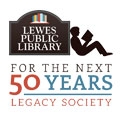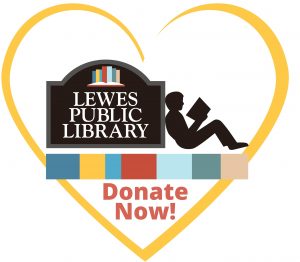Three Hundred Years of Generosity in Lewes
The history of libraries in Lewes, Delaware began with Henry Brooke, a young Englishman who arrived as Collector of Customs at the Port of Lewes in 1702. Brooke brought with him books of poetry, history, theology and the classics, which he generously made available to others. His library was bequeathed to Rev. William Becket of St. Peter’s Anglican (now Episcopal) Church.
history, theology and the classics, which he generously made available to others. His library was bequeathed to Rev. William Becket of St. Peter’s Anglican (now Episcopal) Church.
While other early libraries were formed in private homes, it wasn’t until 1877 that the Lewes Library Association was formed. Many of the founding trustees’ family names are still familiar today – Maull, Burton, Tunnell, Carpenter and Orr.
For 15 years the library was kept at the Odd Fellows Hall at 321 Mulberry Street, where it served 80 members who paid $1 per year for access to 1,000 volumes, and was open every Saturday afternoon. In 1901 the library moved to the Zwaanendael Club at Savannah and Third Street. In 1934, state funding helped create the first Lewes Library Commission, which built a library room in the new Zwaanendael Museum.
Librarian Virginia Marshall, who managed the Lewes Library from 1958 – 1991, oversaw its move from the Museum to a 1,235 square foot wing at the new Lewes City Hall in 1961. State-of-the-art equipment included a Polaroid camera, movie, slide and film strip projectors, and a portable screen.
By 1981, the Lewes Library was serving 8,138 people with a collection of 17,600 books out of a very small space. The Library Board asked Dennis Forney, publisher of The Whale, to work with Flo Coltman and her new Friends of the Library group to plan for a new stand-alone library.
The City contributed the site of the former Lewes railroad depot and funds were raised through bake sales and a cottage tour. Lewes City Council gave the proceeds of the sale of two building lots on Lewes Beach. After six years, ground was broken for a stand-alone 7,900 square foot library at 111 Adams Avenue on June 29, 1986.
In 1999, Friends President William Lowe led a $1 million campaign to increase the Library size to 14,500 sf, planned to suffice for 25 years. In reality, further expansion would be needed in half that time.
By 2013, with a fast-growing service area exceeding 17,000, even the expanded building was too small. Because further expansion was not an option, a new site was identified just across the railroad tracks from the existing library. Working with City officials, this land was purchased to serve as a trailhead for an emerging trail system, an expanded park, and the location for a new, 28,500 sf library, large enough to serve a service population of 30,000.
Local residents were involved every step of the way. First, two group meetings were held with a national expert, Dr. Roger Levien, on evolving uses and designs for libraries. Committees were formed to address potential site evaluations and building design. A citizen campaign committee raised more than $5.5 million, which was matched by the state, to construct the new Library. Altogether, over 700 individual donations and numerous in-kind gifts from local businesses helped make this project a reality.





